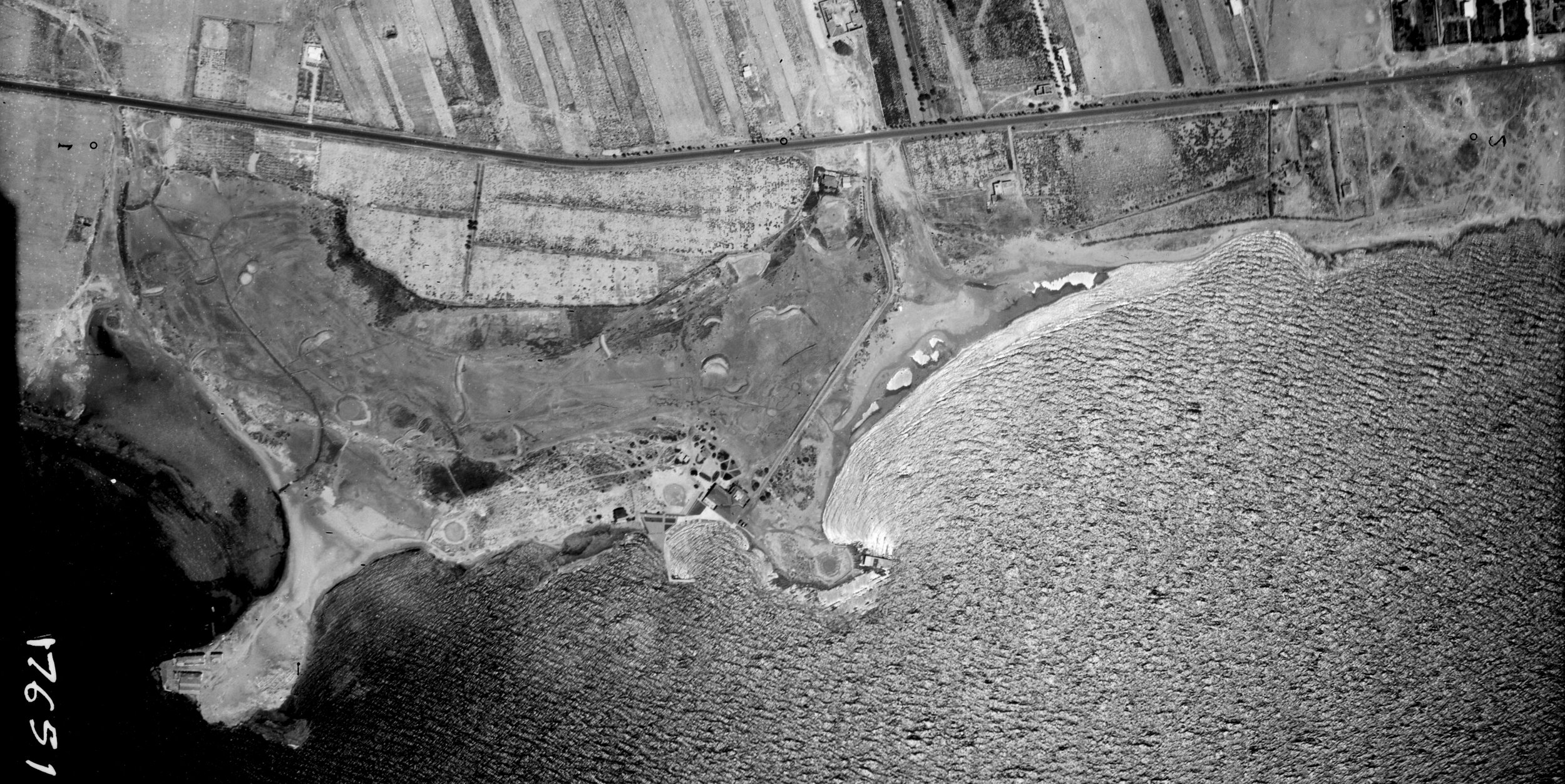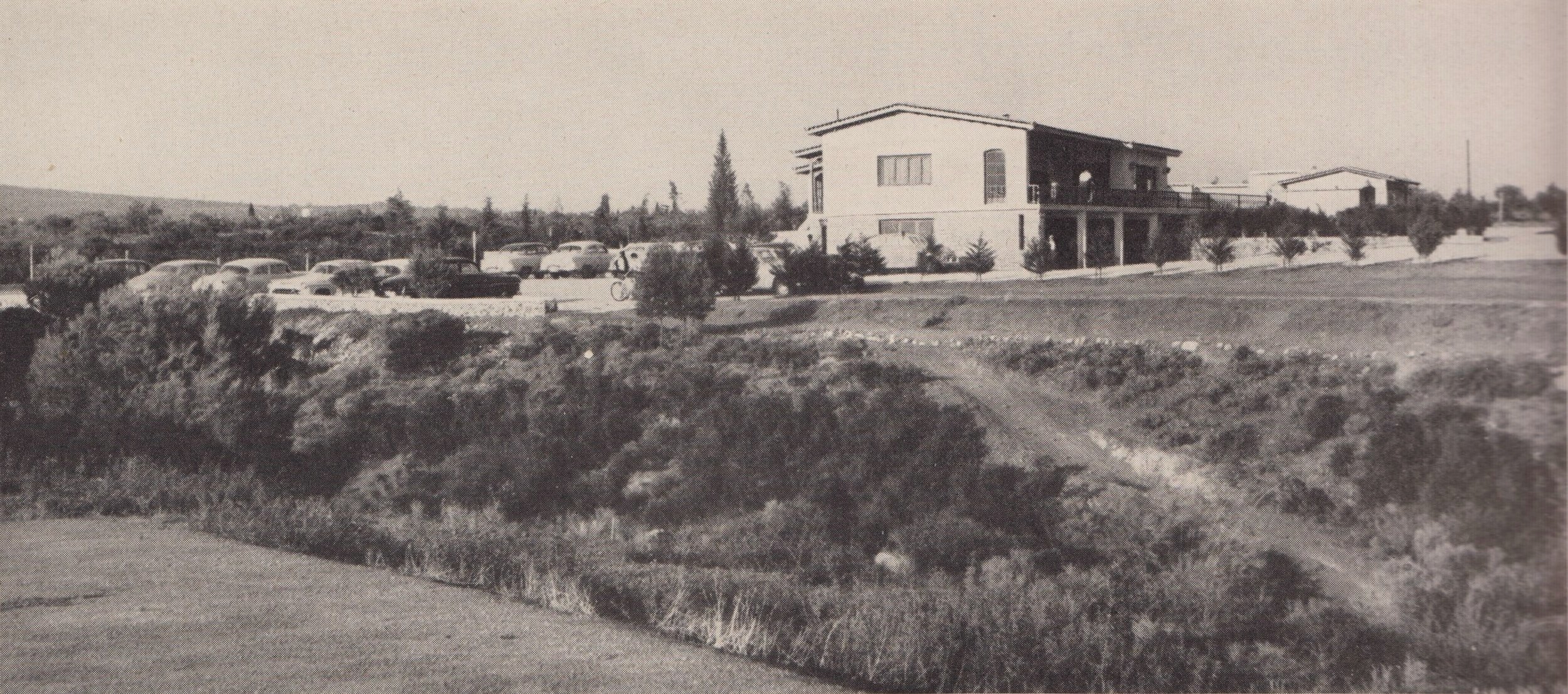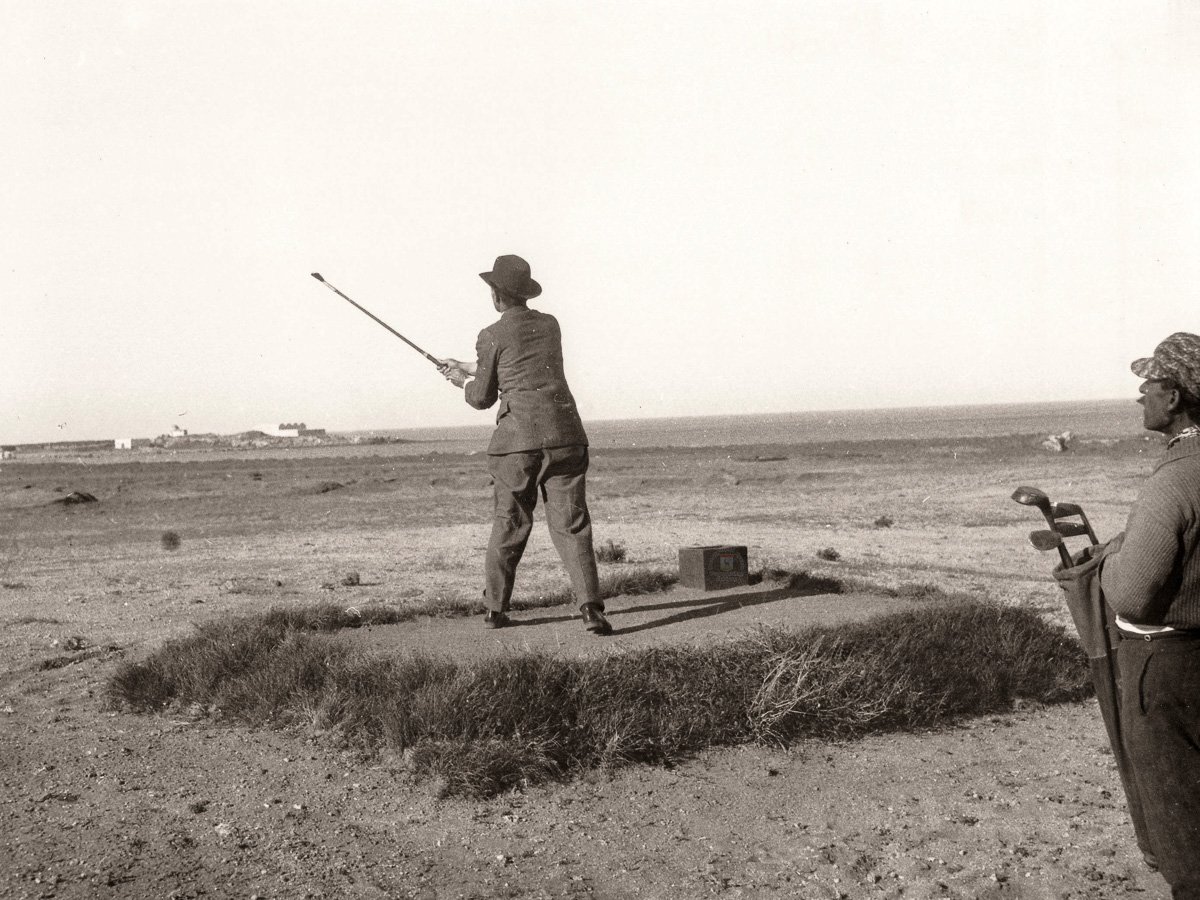
The Story
Lengthwise, the storyline of golfing in Greece is not comparable to a Tolstoy novel. Yet it has many sections that have remained unknown and are well worth of preservation. It also comes with the charm of those efforts that are put on pure white canvas, when something is drafted from scratch. Whenever the old guard spoke, we listened carefully. And stubbornly dug into each visual honeypot we could imagine. Here’s our harvest.
Genesis 1, Verse 1: Souda Bay
According to Christoph Meister, golf historian and vice president of the European Association of Golf Historians & Collectors (EAGHC), the first ever reference of golfing activity in Greece dates back to the late 1890s and a development of a 9-hole layout from British expatriates in Souda Bay, Crete. This is cross-referenced by two sources: The 1898-99 Golfing Annual, which mentions “The course, of nine holes, is at Suda Bay, the river being a formidable hazard” and the February 18th 1899 issue of “The Navy and Army Illustrated”, an official copy of which lies in our desk, which features an article titled “A Nine-hole Course in Crete”.
The golf course was established by the British Army & Navy following their landing on Crete in March 1897 and the detachment of the island from the Ottoman empire by November 1898. The autonomous Cretan State was headed by Prince George of Greece and Denmark. The course at Souda Bay was initially laid out by the officers of the “Revenge” ship in January 1898. By February 1899 succeeding ships had expended time and labour on the Links, creating a nine-hole course that provided a quite fair game. Naval officers who had played a great deal on both courses, declared that much better “gowf” could be had on the Souda Bay Links compared to the older course in Malta. The number of illustrations that accompany the text in the edition stand in full agreement with the geomorphology of the region (especially the characteristic mountain line as witnessed from the river vantage point). The golf course remained in use until 1913, when the last British troops left Crete.

Athens Golf Club
(Agios Kosmas)
The establishment of Athens Golf Club dates back to 1924. A 9-hole links-type course was built along the coast at Agios Kosmas (near Elliniko) as seen in the aerial image of the section footer, stretching to 2250m long. The greens were constructed from heavy sand mixed with oil, flattened with a light road roller and prepared with a wide hard bristle after each round, while fairways were shaped out of dried mud. Social activities were held at the Clubhouse, including annual dances attended by royalties in the late thirties. Mr. Sakellarides was the club secretary and John N. Farrar was the resident British golf professional at Athens Golf Club during the early 1930s. The club had 360 members, the course record was 74 for amateurs and 64 for professionals, held by J.N. Farrar according to the French guide “L’Annuaire des Golfs du Continent 1931” (Ed. Plumon).
It started with a letter from Prince Demidoff to Eleftherios Venizelos on October 22nd, 1924 on which the former requested support towards the creation of a country club with a clubhouse. Venizelos was fond of golfing, which he practiced even hours before his wedding with Helena Schilizzi on Highgate, London in 1921. Count Elim Pavlovich Demidoff (the 3rd Prince of San Donato and richest man on earth in 1895 according to The Atlanta Journal-Constitution), had been the Russian ambassador in Greece at the time. On his letter to Venizelos he wrote "some English men have started a golf course near Palaio Faliro, where they already play the game, but the place still needs considerable improvements”. He estimated that the funds required would rank between 2,000 - 3,000 GBP. Life membership would be GBP 100, honorary members GBP 50 and ordinary members GBP 5 per year. On a later correspondence, secretary M. Jaconith proposed to invite a golf teacher to perfect the course and introduce the game to the members. The club started its operation with Prince Demidoff as its first president in November 1924.
By the late 1930s the club had 400 members and Count Leonardos Merkatis was the club president. His father, Count Alexandros Merkatis, had been a member of the International Olympic Committee from 1897 and participated in the first Olympic golf tournament during the Paris 1900 Olympic Games (golfing was held in Compiègne Golf Club) making Greece one of four nations to compete in this first Olympic golf event (along France, Great Britain and United States). His participation was controversially listed under France, despite him being the captain of the Greek delegation (possibly due to his membership in Compiègne Golf Club in France). The golf course of Agios Kosmas closed with the beginning of World War II in 1940.

Golf di Rodi
During the late 1920s, while Rodos island along with the rest of Dodecanese region was under Italian occupation, commander Mario Lago assigned architect Armando Bernabiti to built a 9-hole golf course with sand fairways and a clubhouse in Acandia area (locally known as Karakonero, different to the modern development at Afandou).
The course opened in 1928. The Links were 2 miles from the centre of the town and ran parallel to the Aegean sea shore. The layout was on undulating sandy ground with short holes (the longest being No.3, measuring 290 yards) and greens made of rolled sand. The course was open for play all year round.
While standing in line for their turn, most golfers practiced Bocce, a quite popular game in Italy that involves a small ball (named pallina) and eight bigger balls which players try to roll as close to the small one as possible.
The daily green fee was one shilling per person and a three month subscription was two pounds, two shillings per person. Within just two minutes’ walk of the clubhouse a fine bathing beach was accessible only by the members and their guests. H.R.M’s Consul Edward Perkins was the club president. The golf course was also closed during the 1940s.

Hellenic Golf Club
(Varympompi)
Since the early 1950s, Athens had a 9-hole course in the northern suburb of Varympompi, managed by Gerasimos Patronikolas, husband of Aristotle Onassis’s sister Callirrhoe. Its fairways were short mowed rough grass with fine grass seeded in the greens and tee boxes. The original 9-holes were designed by architect Herbert E. Gaertner and the construction was supervised by golf professional Emil Dürk. In January 1956 the German magazine Golf reported that Patronikolas was preparing new adjacent land to extend the course to 18 holes, with plans drawn by Gaertner.
G. Sotiropoulos was the head professional and A. Pardalis the teaching assistant. The green fees were 60 Drachmas during the week and 120 Drachmas on weekends. The Club operated until after Glyfada Golf Course opened in 1962 and closed following the death of Patronikolas in 1969. The latest entry is from the 1971 Golfer’s Handbook, which states the course had 9 holes, 2,666m long at Par 60.

Tailoring the backbone
The 1960s and 1970s rightfully rank as the only era when a dedication was evident from the central administration to lay the foundations of a golfing destination. The country’s first 18-hole course opened in Glyfada, Athens, neighboring the former US military base. Two additional courses were developed strategically in the northwestern edge (Corfu Island) and southeast (Rodos Island). The design of all three courses were assigned to Swiss-based golf course architect Donald Harradine. This 18-hole course triad would consist the backbone of the national golfing infrastructure for the following three decades.
The story of Glyfada Golf Course began in the early 1960s, when the National Tourist Organization of Greece (EOT) started site preparations in the namesake southern suburb of Athens. The course opened in 1962 as a 9-hole and a year later as a full 18-hole layout. The initial numbering of the holes was different to the current one and a small river was crossing current holes 18,16,15,10,1,9, the bed of which was covered later on. On 1965, "Shell's Wonderful World of Golf" television series was hosted on the course on a match between Roberto De Vincenzo and Tony Lema with Gene Sarazen on the commentary (the impressive coverage of the full match can be watched here). In 1966, 198 founding members established Glyfada Golf Club of Athens and soon took charge of the course’s administrative role, shifting its status to a members club.
Over in Corfu island, Charalampos Tsaoussoglou, businessman and close friend of Konstantinos Karamanlis, trusted the Prime Minister's instinct and belief on effectively luring upscale tourism through a golf course investment and bought a land in the heart of Ropa valley for that exact matter. The club was designed in 1967 and completed in 1971. It has remained under the same family administration status ever since and remains the course with the most water hazards in Greece by implementing 7 ponds, each representing one of the seven islands of the Ionian sea.
In 1973 the National Tourist Organization of Greece also inaugurated Afandou Golf Course in Rodos island on a pristine location spanning across the eastern shoreline of the island. At the same time, in northern Greece, shipowner Giannis Karras started constructing a luxury complex along with vast extents of vineyards, olive groves, gardens and a golf course in a cove near Neos Marmaras. Karras had found a safe haven in this cove a few years earlier, during a yacht trip under fierce weather and decided to own this land. The impressive main hotel building (Meliton) was designed by none other than Walter Gropius, the founder of the Bauhaus movement. The golf course still consists the solitary golf course in continental northern Greece.
On November 8-11th 1979, the Golf World Cup organized by the International Golfing Association was held in Glyfada. For the occasion, Robert Trent Jones had been assigned with the redesign of the course. A number of additional trees were planted in order to narrow the fairways and more sand bunkers were added so as to increase the challenge. On the 72-hole stroke play team event, US Hale Irwin and John Mahaffey won the trophy with Scotland’s Sandy Lyle and Ken Brown finishing second. In the individual scores Irwin was first with West Germany’s Bernhard Langer finishing second. The Greek team of Vasilis Anastasiou and Vasilis Karatzias ranked 23rd amongst the 45 teams. In a move that induced controversial response from the players and international press, the Greek Foreign Minister expelled the South African team of Dale Hayes and Hugh Baiocchi, following a request from the United Nations Special Committee against Apartheid to condemn all practices of racial segregation in sports.

In Praise of Idleness
As promising as the 1970s waived with a World Cup organization and four newly established golf courses, the following two decades would be mostly spent in a state of inertia in terms of golfing development and growth. The only bright beacon being the construction of a 9-hole course in Elounda, Crete, as a part of a luxury resort.
From 1993, Glyfada Golf Course’s administrational status shifted from a member's club to a municipal enterprise, offering significantly lower green and membership fees but at the same time varying levels of maintenance status, ranging from excellent to inadequate, depending heavily upon the prioritization of the respective municipal authority through the years. In 1999 and for three consecutive years, Glyfada became an official stop of the European Seniors Tour, an initiative organized by TEMES, the construction company and owner of Costa Navarino resort.
The U-turn
Shortly after the millenium, the new owners of Porto Carras resort refurbished the golf course and re-branded it as “The Olive Grove”. The makeover included the relining and reshaping of the lakes as well as an installation of an irrigation system and reseeding with paspalum grass.
The big news, however, were related with the construction of Crete Golf Club in 2003 which was a stone’s throw in golfing waters that had remained swampy for too long. The attempt was quite challenging in engineering terms, as it dended extensive soil preparations over a formerly rocky mountainous region in order to accommodate fairways and greens. It also required unprecedented collaboration between the state and an extensive number of landlords that were also the shareholders. The result did justice to those who envisioned it as well as to those who evolved it along the way. In 2006 the course hosted the 1st Aegean Airlines Pro-Am Tournament that has become an annual event since. The course closed for a renovation during 2014-2015 and a 5-star hotel was built next to the course that started its operation in 2017.
An undisputed milestone of golfing in Greece was year 2010, which marked the opening of Costa Navarino resort in Messinia. The luxury resort initially featured an EGA-designed signature course by Bernhard Langer (The Dunes Course), with a Robert Trent Jones II-designed course (The Bay Course) following just a year later. The whole attempt not only reintroduced Greece on the golfing Atlas, but on a broader term shifted a whole region that was a scenic land, full of olive groves, to a global destination that induced the optimization of the road network as well as the upgrade of the international airport in the nearby city of Kalamata. Two additional golf courses were recently introduced in 2022 designed by Jose Maria Olazabal (The Hills and The Olympic International Academy). All four courses are clustered within a conveniently tight radius of 13-km. The skeptics on Greece’s golfing potential gradually aligned with the frontline of golf media, that nowadays include the region in their highest ranked golfing destinations worldwide. As of 2023, the four Costa Navarino courses along with Crete Golf Club consist the spearhead of the national golf course infrastructure.
Bernhard Langer on The Dunes Course
Robert Trent Jones II on The Bay Course
Jose Maria Olazabal on Olympic Intl. Academy Course
Olive Tree Transplantation
Where Do We Go From Here?
The front 9 of a Jack Nicklaus Signature par-18 course in Kilada, Eastern Peloponnese has been completed. Afandou in Rodos will be fully redesigned (again by Nicklaus design), on a €10+ million investment that is part of a far greater business plan that includes hotels and marinas (read more on those highly anticipated courses in our interview with Dirk Bouts, Nicklaus company head designer).
Legislative decisions are addressed in favor of a brand new course in Saronida, Attica, so as to provide an alternative to Glyfada in the broader metropolitan area of Athens of 5 million residents. Glyfada Golf Course itself, is neighboring the area of the old Athens airport, which is currently transformed into a vast metropolitan park with skyscrapers, premium hotels and shopping malls. Even a municipal course will be hard to remain unaffected by the constructional boom and not soon become part of a private investment.
Pitch-and-putt gardens are blossoming in old highways in Corinth next to vintage American diners. Driving ranges open in the northern suburbs of Athens and rumors of a full course in the vicinity of the old course of Varympompi are getting louder.
And while the previous generations had succumbed once too many to the belief that things are finally getting there, this time it seems as if it won’t be long until 10 high-end courses will be offered within a land small in extent but grandiose in weather, cuisine and cultural heritage.
So, take an extra sip of your favorite beverage before rushing to book that same old golfing destination of your annual golf trip. Visit for the courses, stay for the cultural heritage overdose on a fore’s reach, the culinary delights, the beach life without sharks or uninviting ocean temperatures and the climate that renders beanies, mittens and neckwarmers virtually useless.
Don’t be shy to drop a line in our email, either. We’ll be delighted to contribute.
Golf Greece would like to acknowledge the sincere support of Mr. Adam Sofronis, Mr. Stavros Maniotis, Mr. Christoph Meister, Mr. George Ginis, Mrs. Christiana Kouliga, Mr. Vasilis Karantzias, Mr. George Sotiropoulos and Mr. Stavros Georgalidis.






























